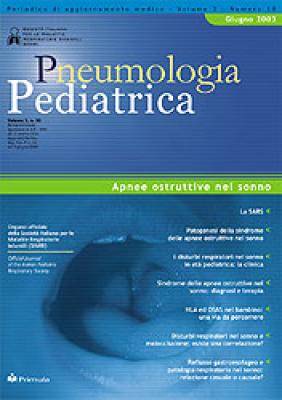Archivio > Vai alle uscite del 2003 > Vai aVolume 3, Numero 10 - Giugno 2003
- Apnee ostruttive nel sonno
HLA ed OSAS nel bambino: una via da percorrere HLA and OSAS in children: a path to undertake

Riassunto. Molti studi condotti sugli adulti suggeriscono come la prevalenza dei sintomi riferibili ad OSAS tenda progressivamente ad aumentare nei soggetti che hanno parenti affetti da tale disturbo.
Per valutare il ruolo dell’HLA nell’OSAS abbiamo condotto uno studio su 39 bambini (28 M e 11 F di età compresa tra 1 ed 11 anni) ai quali era stata fatta diagnosi di OSAS mediante una polisonnografia notturna. Tutti i bambini sono stati sottoposti a tipizzazione degli antigeni HLA ed i risultati sono stati confrontati con la distribuzione degli antigeni HLA della popolazione pugliese.
Il nostro studio dimostra che la frequenza degli antigeni HLA-DR3, HLA-DQ2 ed HLA-A33 è aumentata nei bambini con OSAS rispetto alla popolazione pugliese (25,64% vs 12,8%, p= 0,03; 46,15% vs 29,10%, p= 0,03 e 12,82% vs 4,6%, p= 0,02 rispettivamente).
Il nostro studio sottolinea l’evidenza di una possibile associazione dell’OSAS con gli antigeni HLA-DR3, HLA-DQ2 ed HLA-A33.
Summary. Many studies performed on adults suggest that the prevalence of OSAS symptoms tends to progressively increase in subjects whose parents are affected by this disorder.
In order to evaluate the role of HLA in OSAS we performed, between January 1999 and January 2001, a study on 39 consecutive children (from 1 to 11 years of age) who had been diagnosed with OSAS by night polysomnography. All presented excessive snoring, apneic episodes during sleep, oral breathing, and daily sleepiness. All children underwent HLA antigen typing and the results were compared with the distribution of HLA antigens of the Apulian healthy population.
In our study the frequency of HLA-DR3, HLA-DQ2, and HLA-A33 antigens showed to be markedly higher in children with OSAS than among the healthy Apulian population (25,64% vs 12,8%, p= 0,03; 46,15% vs. 29,10%, p= 0,03 and 12,82% vs 4,6%, p 0,02 respectively). Children with HLA-A33 and/or HLA-DR3 and/or HLA-DQ2, with or without OSAS were homogeneous for BMI, AI and ODI.
These results suggest that having an HLA-A33 and/or HLA-DQ2 and/or HLA-DR3 may increase the likelihood of having OSAS.






